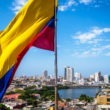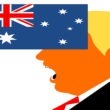When scattered protests broke out in Iran at the end of December, Donald Trump took enthusiastically to Twitter to interpret the events for the rest of the world: “The people of Iran are finally acting against the brutal and corrupt Iranian regime. The people have little food, big inflation and no human rights. The US is watching!”
And again: “The USA is watching very closely for human rights violations!”
The press breathlessly followed suit. As Oxford-based historian of modern Iran Eskandar Sadeghi-Boroujerdi observed on December 30, “Within the space of some 24 hours, nearly every mainstream Western media outlet has inclined to assimilate legitimate expressions of socio-economic distress and demands for greater governmental accountability into a question of ‘regime change.’”
Unsurprisingly, no such ruckus was elicited by events much closer to home—in that part of the so-called U.S. “backyard” known as Honduras—where protests following November elections that were widely denounced as fraudulent had reportedly left at least 31 dead by the beginning of January.
Indeed, the United States has never watched too closely for human rights violations in Honduras—perhaps because the United States is itself often complicit. (Not that the gringos haven’t been implicated in abuses in Iran: the 1953 CIA coup that overthrew Mohammad Mossadegh, the demo- cratically elected prime minister, comes to mind, as does the ensuing reign of the notoriously repressive shah, a dedicated U.S. ally and obsessive purchaser of American weapons.)
Back in the 1980s, for example, Honduras was the playground for the CIA-trained death squad Battalion 3-16, while also serving as a launchpad for the U.S. Contra war on neighboring Nicaragua—a lengthy affair that was blatantly irreconcilable with even the most forgiving of human rights standards.
The United States played a starring role following the 2009 coup d’état against Honduran President Manuel Zelaya, who had veered slightly from the straight and narrow path of obsequiousness to the predatory capitalism so favored by the United States and its acolytes in the Honduran oligarchy.
While the Obama administration spent months pondering whether the military overthrow of a democratically elected president in fact qualified as a coup and should thus trigger massive cutoffs in aid, the Honduran coup regime labored to create irreversible facts on the ground culminating in illegitimate elections in November 2009. After that, the United States insisted that the world swiftly welcome Honduras back into the club of respectable global democracies.
As it turns out, Secretary of State Hillary Clinton had also been laboring behind the scenes to ensure that a reinstatement of Zelaya was averted at all costs. We know this because she told us so in her 2014 memoir, Hard Choices. However, the relevant passage was mysteriously disappeared from the paperback edition the following year.
I myself spent four months in Honduras in the aftermath of the coup—or the “presidential succession,” as the Honduran right wing dubbed it—and was thus able to witness the total impunity with which state security forces operated. While anti-coup protests were overwhelmingly and almost exasperatingly peaceful, the state’s response was not. I watched as old ladies were blasted by water cannons loaded with pepper spray. I attended the burial of union leader Jairo Sánchez, shot in the face by police.
And the supposed restitution of democracy did nothing to alter the trend. The post-coup era has been characterized by skyrocketing homicide rates—with a surge in femicides and murders of journalists, environmental activists, and other troublesome sectors of the population.
And the supposed restitution of democracy did nothing to alter the trend.
Whereas in Iran’s case, the United States rants and raves about human rights violations and terrorism to ensure that the country is not integrated into the global economy on any terms other than America’s own, state repression in Honduras is more than compatible with U.S. financial interests and corporate exploitation.
Case in point: The slogan of the post-coup Honduran government of Porfirio Lobo was none other than “Honduras is Open for Business,” which was music to the ears of international investors delighted that the country had been rescued from any sort of economic sovereignty. And open for business it remains under Juan Orlando Hernández, returned to power in November elections flagged as extremely dubious by numerous observers, including the Organization of American States. (It bears mentioning that a formerly sacred ban on the reelection of Honduran presidents was magically rescinded during Hernández’s first term—despite having been used to justify the overthrow of Zelaya, who according to the imaginative propaganda of the Honduran elite had been conspiring to become president for life and convert Honduras into a mini-Venezuela.)
Amidst the current bloody postelection crackdown, The New York Times notes that, “two days after the vote [the U.S. State Department] certified that Honduras was meeting human rights conditions, strengthening transparency, and cracking down on corruption”—a certification required for the release of U.S. aid to Honduran security forces for “counter-narcotics” and other programs. Never mind recent headlines from The Intercept like: “Top U.S.-backed Honduran security minister is running drugs, according to court testimony.”
But while the United States may care little about Honduran protests against perceived electoral fraud, Iranian protests on exactly the same subject are a different matter. In June 2009—the very same month, incidentally, as the coup against Zelaya—the United States was very, very interested in a postelection crackdown in Iran.
In a two-part study titled “Iran and Honduras in the Propaganda System,” the late Edward S. Herman—formerly professor emeritus of finance at the Wharton School, University of Pennsylvania—and researcher David Peterson explored discrepancies in media coverage of the killing of 27-year-old Neda Agha-Soltan, shot by Iranian security forces, and that of 19-year-old Isis Obed Murillo, shot by Honduran security forces at an anti-coup demonstration.
Based on a large sample of English-language media, Herman and Peterson found that “Neda’s death was mentioned…107 times as frequently as was Isis’s—and this discrepancy doesn’t begin to convey the kind of passionate indignation expressed over Neda’s death and the complete lack of anything remotely similar over the death of Isis.”
Furthermore, the authors report that, “by a ratio of 35-to-1, newspapers showed more interest” in Agha-Soltan’s death alone than in the aggregate deaths of 24 Honduran protesters, journalists, social organizers, and human rights advocates.
In a dispatch for the North American Congress on Latin America (NACLA), Michael Corcoran similarly found that The New York Times devoted some 38,000 words, “including 15 front-page articles,” to Iran in the 10-day period following the June 2009 elections. Honduras, on the other hand, got a mere 3,000 words and zero front-page time in the 10 days following its own transparently illegitimate elections in November 2009—in which Washington’s neoliberal accomplices of course emerged victorious. (It also got a Times editorial praising the election as “clean and fair.”)
Now, almost a decade later, the “government-media nexus” highlighted by Herman and Peterson shows no signs of abating. Ditto for U.S. insistence on wielding “human rights” as a politically expedient weapon.
Many of the same media commentators who went after Iran in 2009 without so much as a peep about Honduras are at it again during the renewed Iran- Honduras overlap. Some newer faces are also on the scene, including that of one Amir Fakhravar—Iranian exile, fan of Israel, and author of the curious Comrade Ayatollah: Soviet KGB’s Role in the Islamic Revolution and the Rise of Khamenei to Power in Iran. In January, Fakhravar swore to Fox News that “the people in Iran…love President Trump,” and went on to volunteer the Iranian people to “be the army of the world to make the world free from the small group of fanatic mullahs who are in power in Iran.”
Judging from my own visits to Iran, it seems there are plenty of citizens with very different visions of freedom. Even Iranians I spoke to who self-defined as anti-government made it clear that they considered U.S. sanctions as a cruelly arbitrary form of human rights abuse in themselves.
In the end, President Trump can emit as many “US is watching” Twitter-threats as he wants. But as the United States strives to perfect the art of the double standard in Iran, Honduras, and beyond, the world is watching back.
Belén Fernández is the author of The Imperial Messenger: Thomas Friedman at Work, published by Verso, and Martyrs Never Die: Travels through South Lebanon, published by Warscapes. She is a contributing editor at Jacobin magazine.







0 Comments